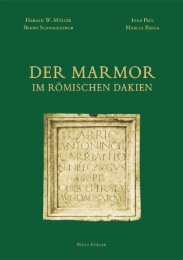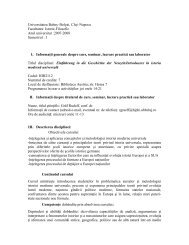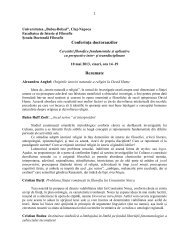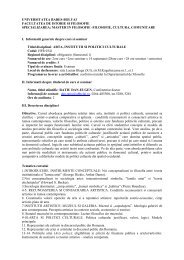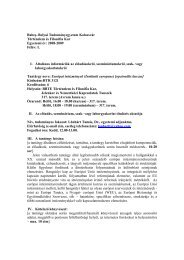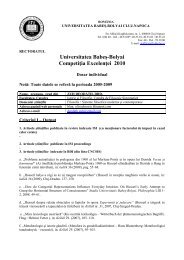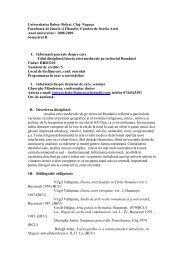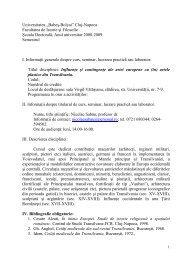SCRIPTA CLASSICA. RADU ARDEVAN SEXAGENARII DEDICATA
SCRIPTA CLASSICA. RADU ARDEVAN SEXAGENARII DEDICATA
SCRIPTA CLASSICA. RADU ARDEVAN SEXAGENARII DEDICATA
Create successful ePaper yourself
Turn your PDF publications into a flip-book with our unique Google optimized e-Paper software.
<strong>SCRIPTA</strong> <strong>CLASSICA</strong>.<br />
<strong>RADU</strong> <strong>ARDEVAN</strong> <strong>SEXAGENARII</strong><br />
<strong>DEDICATA</strong><br />
Editors:<br />
Ioan Piso<br />
Viorica Rusu-Bolindeţ<br />
Rada Varga<br />
Silvia Mustaţă<br />
Eugenia Beu-Dachin<br />
Ligia Ruscu<br />
MEGA PUBLISHING HOUSE<br />
CLUJ-NAPOCA<br />
2011
ISBN 978–606–543–196–6<br />
BABEŞ-BOLYAI UNIVERSITY<br />
DEPARTMENT OF ANCIENT HISTORY AND ARCHAEOLOGY<br />
CENTRE FOR ROMAN STUDIES<br />
COPYRIGHT: © 2011 THE AUTHORS OF THE ARTICLES<br />
DTP: Andreea Macavei<br />
Cover: Romeo Cîrjan<br />
Plates and figures: Silvia Mustaţă<br />
© MEGA PUBLISHING HOUSE<br />
CLUJ-NAPOCA<br />
E-MAIL: mail@edituramega.ro<br />
www.edituramega.ro
VETERAN SETTLEMENT AND COLONIA<br />
ULPIA TRAIANA SARMIZEGETUSA<br />
George CUPCEA *<br />
ABSTRACT: This paper concerns the settlement of veterans after their<br />
discharge and its evolution in the last century of the Republic and the<br />
first two centuries of the Empire, with special regard to colonia Ulpia<br />
Traiana Augusta Dacica Sarmizegetusa. As veteran settlement decreases<br />
gradually in the 1 st century AD, at the beginning of the 2 nd we have little<br />
such activity from the part of the emperors. Considering the analogies<br />
in Britannia and elsewhere, as well as the statistics for veterans in other<br />
provinces, the paper focuses on Sarmizegetusa and its beginnings. A first<br />
wave of colonists, of which a part are legionary veterans, is traceable at<br />
Sarmizegetusa, and together with recent topographical research, confirm<br />
the primate of the city at this particular place, and not necessarily its development<br />
from a hypothetical fortress.<br />
KEYWORDS: missio; veterans; Sarmizegetusa; colonia; discharge.<br />
Beginning with 13 BC the veterans were financially compensated, and finally, by 6 AD aerarium<br />
militare came into being, together with praemia militiae 1 . Thus, the compensation of soldiers at<br />
the time of their discharge was no longer a privilege, but a right. It seems that these decisions were<br />
taken by Augustus under the pressure of events, because the men were no longer available for long-term<br />
service without any proper compensation. The emperor normed a scale for gratuities, in which the praetorians<br />
received 5000 denarii after 16 years of service and the legionaries 3000 denarii after 20 years 2 .<br />
However, this system was not fully instated, because by 14 AD, the soldiers retired are complaining<br />
about the bad state of the land that they received 3 . Thus, it is noticeable that land allotment was as in<br />
use as financial compensation, but not as popular as the latter 4 . Through this, the veterans were settled<br />
in colonies, but not in the old, republican manner 5 , together with their centurions and tribunes,<br />
* This work was supported by a grant of the Romanian National Authority for Scientific Research, CNCS-UEFISCDI,<br />
project number PN-II-ID-PCE–2011–3–0096<br />
1 Res Gestae 17.<br />
2 Dio 55.23.<br />
3 Tacitus, Ann. 1.17.<br />
4 Watson 1969, 147.<br />
5 Tacitus, Ann. 14.27.
242▕ George CUPCEA<br />
to create a society based on already build relations, and the result was not the best, because most of<br />
the soldiers preferred to return to the provinces where they served, not being accustomed with social<br />
or family life 6 . By the time of Hadrian the situation alters, veteran colonies are no longer founded,<br />
probably due to the high price of land or imperial policy concerning settlement. At the same time, the<br />
local recruitment is the rule, which will generate a local settlement after the discharge. Somewhat surprisingly,<br />
no evidence for auxiliaries’ praemia militiae is to be found, except for the marines in the time<br />
of Vespasian. It seems that the auxiliaries, as non-citizens, were not entitled to praemia militiae and<br />
the privileges received through their diplomas were regarded as enough compensation. In Augustus’<br />
reign the cohortes civium Romanorum enjoyed the same privileges as the legionaries at their discharge<br />
(Tacitus, Ann. 1.8), but this also was altered eventually 7 .<br />
Military service itself was looked upon as a civilizing agent, producing through discharge, almost<br />
5000 new citizens yearly. Together with their families, we can say that the army was responsible for the<br />
increase in the citizen corps by 3 Million people. Thus, the value of citizenship decreased gradually, and<br />
the constitutio Antoninana was probably no shock 8 . The veterans enjoyed a special status especially in the<br />
military provinces, where they were more easily integrated into urban societies. Therefore, they naturally<br />
gravitate around the forts, the vici and canabae being the proper environment for their retirement 9 .<br />
For most of the veteran colonies founded in the civil wars period, evidence of centuriation has been<br />
traced. In all the cases, the veterans were settled at the site exactly at the moment of foundation. The colonisation<br />
of veterans was conducted in several stages, going all the way into the first half of the 1 st century<br />
AD. When the colonies were founded, they also received substantial territoria, and so the neighbouring settlements<br />
were expropriated for this, leaving their citizens uncompensated. Most of their monuments don’t<br />
indicate a very prosperous social and economic status, except for those of the centurions and tribunes 10 .<br />
Augustus founded Emona as a colony for the veterans of the Pannonian and Illyrian legions, but<br />
he also repopulated Narona and more settlements of this kind in the Rhine area. But the veterans’ reaction<br />
to this form of compensation has discouraged Tiberius in the founding of such colonies. Claudius<br />
again stimulated it, but mostly in the provinces, probably because he understood their primordial role<br />
here. Nero took a new initiative in the founding of Italian colonies. Finally, the civil war of 69 AD caused<br />
a new stage in the founding of veteran colonies, by Vespasian, but his two sons didn’t follow 11 .<br />
The establishment of the permanent Principate army did no longer allow the deduction of veterans<br />
in the way that it was done after the civil wars of the later Republic. First because the legions are now garrisoned<br />
on frontiers, away from Italy, second because the share of Italians in the legion dropped dramatically,<br />
thus, the veterans lacking in a reason to settle there. Finally, also because now the number of veterans produced<br />
yearly by a legion didn’t exceed 100–200, with no more entire units available for discharge at once.<br />
The emphasis is switched on the provinces, beginning with Claudius, in the way of the gathering of all the<br />
veterans of a provincial army in a new colonia, which will have its population increased eventually. The only<br />
1 st century emperors that have an Italian founding policy are Nero and Vespasian. They attempt, on one<br />
hand, to follow the examples of Caesar and Augustus, especially after 69 AD and on the other to revive<br />
the declining Italian economy. Plus, the Flavian emperors and the first two Antonines tried to increase the<br />
numbers of the free population in Italy. But by this time, most of the legionary and praetorian veterans<br />
6 The foundation of colonies was the way in which the Romans wanted to impose their ideology in the newly conquered<br />
areas. Veteran settlement wanted to transform the professional soldiers into respectable citizens, to avoid their association<br />
in crime. In some cases, the places for these colonies were former fortresses, because the men were accustomed to the venue in<br />
25 years. The new coloniae oferred many advantages, not only a strategic position in young provinces, but, by the return of the<br />
veterans’ sons in the army, they ensured a supplementary recruitment fund (Tacitus, Ann. 14.31). Webster 1998, 283–284.<br />
7 Watson 1969, 148–149; Wesch-Klein 2007, 444–445.<br />
8 Webster 1998, 285.<br />
9 Watson 1969, 153.<br />
10 Mann 1983, 57–60; Keppie 2000a, 249, 258–259. Such a situation is to be encountered in the colony of Forum<br />
Iulii, where we cannot determine the units of the veterans settled, but we can establish that veteran settlement in Narbonensis<br />
and Italia at the end of the Republic and the beginning of the Principate has not been a singular, but a repetitively process.<br />
Keppie 1995, 367–372.<br />
11 Mann 1983, 57–60; Keppie 1984, 77–81.
Veteran settlement and Colonia Ulpia Traiana Sarmizegetusa▕ 243<br />
received their compensations as sums of money. Some returned to Italy or their provincial home, but most<br />
of them remained close to the place where they spent most of their mature life 12 .<br />
The veteran colonies are vital to the recruitment of legions, because military tradition stimulates<br />
the interest for a career in this environment. Sadly, by the end of the 2 nd century, the number of recruits<br />
from the Romanized areas dropped and colonies were no longer founded. Hadrian founded Mursa, in<br />
Pannonia Inferior and Aelia Capitolina, he also promoted Apollonia to the rank of colonia. After his<br />
reign the legions rarely changed their location, the single such event being the shift of V Macedonica<br />
from Troesmis to Potaissa. Although many veterans settled in Troesmis, no colony was ever founded<br />
there. Moreover, new conquests ceased to appear, thus, making very cheap the foundation of such cities.<br />
The economic conditions of the later 2 nd century show that it was more profitable for the state to<br />
pay sums of money to the discharged soldiers than to offer them land. Local settlement of the soldiers<br />
provides a home for them also during service, but also children that are not citizens. By the end of the<br />
3 rd century, the land allotment was conditioned by the enlistment of the veterans’ sons in the army, all<br />
culminating with the hereditary army of the 4 th century 13 .<br />
Veteran deductions are made only with legionaries, praetorians and classiarii, in a well determined<br />
space, but the deductio doesn’t tie them to their land. There is no evidence for auxiliaries’ deduction, probably<br />
because, as new citizens, they lacked the civilizing mission of their colleagues, old citizens. However,<br />
auxiliary veterans choose to live in cities, but only where their privileges are granted. Such cases are encountered<br />
in Mauretania Caesariensis, where most of the veterans settled in cities that had fiscal privileges,<br />
as it is the case of municipium Volubilitanorum, which had its fiscal immunity granted by Claudius 14 .<br />
Of the colonies founded at the beginning of the Principate, we notice that some of them were<br />
previously legionary fortresses, but were liberated after the moving of the legion, and occupied by civilians.<br />
This is the case mostly in Britannia, at Colchester, Lincoln or Gloucester. Other republican<br />
colonies, as Ostia or Minturnae have the shape of military camps, because during the conquest of Italy,<br />
the Romans developed cities in previous garrisons, if they were in a strategic position. The ‘playing card’<br />
shape of some Augustan colonies, Aosta and Turin, is actually not a proof of their previous existence<br />
as legionary fortresses. The same is the situation of Emona, the traces of a hypothetical XV Apollinaris<br />
fortress lacking, in spite of its obvious strategic position. It has been assumed that Claudius founded<br />
colonia Claudia Ara Agrippinensium on the site of the fortress of I Germanica and XX legions, after their<br />
move to Bonn and Neuss, but research has shown the opposite, the actual place of the fortress being still<br />
unknown. In Britain, Claudius founded at Camulodunum colonia Victricensis, exactly on the spot of the<br />
legionary fortress of XX Valeria victrix. In Dalmatia, in the former territory of a legion such a colonia<br />
was founded. Vespasian founded two colonies in Pannonia, Siscia and Sirmium, which probably were<br />
Augustan fortresses. The situations of III Augusta and Theveste or II Adiutrix and Lindum are similar.<br />
Nerva did the same with Gelvum, Traian with Poetovio, from where XIII Gemina left, and Oescus. The<br />
case of Sarmizegetusa seems unsure, probably as those of Savaria, Ratiaria, Scupi and Mursa. At Vetera<br />
the civil settlement is born in the cannabae, not in the temporarily abandoned fortress 15 .<br />
The special interest for the places of former garrisons is obvious. The land in the former legionary<br />
territory remains in the property of the state and can be reused and allotted to veteran colonists.<br />
Their number is unsure, although during the Republic figures as 3000 are mentioned, in Palma,<br />
Cartagina or Aosta. However, in the Principate no such availability of veterans existed at one time,<br />
and probably the colonization was made in stages. Most of the times, all the veterans of the province<br />
are gathered in a new colonia, as the cases of Ptolemais, Syria or Gloucester have been traced.<br />
In Colchester it is obvious that the city was moved into the legionary fortress, probably not to ruin<br />
an area which lived well out of the soldiers’ money. It is a misconception that these veterans lived in<br />
the city. They had land allotted in the city territory and were expected to live on it and produce; the<br />
emperor didn’t need them as urban plebs. Some of them probably had employees, and they actually<br />
12 Mann 1983, 60; Keppie 1984, 105–107.<br />
13 Mann 1983, 63–65, 67.<br />
14 Mirković 2007, 328, 338–339.<br />
15 Keppie 2000, 302–305.
244▕ George CUPCEA<br />
lived in the cities, but those were officers, centurions or tribunes that were also city magistrates. But<br />
the majority remained moderate farmers, as most of them are attested in their rural residencies, in<br />
the city territory. In the later Republic a veteran was allotted 12 ha, and probably this ratio was not<br />
decreased during the Principate in the provinces. The first step in the founding of such a colonia was<br />
the detachment of a surveyors’ commission that would measure the land and divide it into centuriae.<br />
The tradition requires this to be the starting point, confirmed by research all over the Empire. In<br />
Britannia no centuriation traces have been discovered in any of the territories of the colonies founded<br />
on former fortresses 16 .<br />
Therefore, the placement of colonies exactly on the site of the legionary fortress is not the common<br />
practice in all the Empire, outside of Britain the situation inclining towards their placement in the<br />
vicinity, over the cannabae, and the connection between the military and civil environment being simply<br />
assumed. Moreover, the situation in Britain is a counterargument, because serious problems occurred<br />
with the social integration of veterans in many such settlements 17 .<br />
By the time of Trajan it was obvious that most of the veterans were not eager to become farmers.<br />
In Poetovio, founded around 100 AD, the veterans could choose between missio agraria and<br />
missio nummaria, the latter also intending to live in the new city and to have their own enterprises. The<br />
placement of these colonies is a strategic matter, also related to the legionary fortress in the province;<br />
Vespasian settled veterans in Ammaus, on the road from Jaffa to Jerusalem, and Trajan settled them at<br />
Thamugadi, 20 km from Lambaesis 18 . After Hadrian such colonies were no longer founded, veterans<br />
being awarded money at their discharge, which they would invest freely. It was not interrupted the<br />
elevation of cities to the state of colonia, especially those in the vicinity of fortresses in the Danube area,<br />
Aquincum, Carnuntum, Apulum 19 .<br />
The 3000 denarii received by a veteran on discharge, invested with a medium interest of 6%<br />
could allow him a decent yearly rent for the rest of his life. Adding to this the business and economies<br />
made in service, plus the inheritances, probably the veteran didn’t have a bad financial situation. The<br />
veterans had the bases for a decent profession, if they desired to learn it, during their service. They could<br />
be various craftsmen, doctors or surveyors, but evidence is scarce for veterans with other professions<br />
than that of farmer. These other veteran professions usually mean some kind of a merchant – vestiarius,<br />
negotiator gladiarius, or ship builder – naupegus, owner of oil presses, dye-works or tile and pottery workshops.<br />
It’s not entirely clear if the veterans that were owners of villae rusticae or other enterprises were<br />
working alone or had any employees, but it probably depended on rank and material possibilities. They<br />
obviously had serious expenses, as are family upkeep or rent 20 .<br />
The veterans of Egypt seem to have lived in a modest prosperity. The farmers were not working<br />
themselves, because they had employees or tenants, or even slaves, mostly the ex principales. Sometimes<br />
they own small businesses or workshops, but these remain very poorly developed, very rare being the<br />
cases when veterans extend their properties in more than one settlement, or the major commercial transactions.<br />
If in their native villages the veterans were somewhat important, the access into cities was not as<br />
easy. It required a rather large fortune, Greek education and social status, sometimes obtainable through<br />
marriage. Even in cities, the veterans and their sons were considered the lowest rank of citizens and their<br />
path towards public offices was closed, the sole way of climbing the social pyramid remaining military<br />
service. The only city where the population has also a military origin is Antinoopolis, and here the veterans<br />
have a compensatory privileged status. As marginals, they seek association with their comrades,<br />
concentrating in real military families. The soldiers and veterans assume Roman cultural values, as Latin<br />
and the Roman law, but only on the official level. Thus, the veterans in Egypt are a class regarded with<br />
suspicion and only partially integrated, and their role in the Romanization is lacking 21 .<br />
16 Keppie 2000, 306–308. This will prove to be important, if not decisive, for the case of Sarmizegetusa.<br />
17 Keppie 2000, 309–311.<br />
18 Also Sarmizegetusa is at half-way from Apulum to Berzobis.<br />
19 Keppie 2000, 311–312.<br />
20 Wesch-Klein 2007, 445–446.<br />
21 Mitthof 2000, 389–393.
Veteran settlement and Colonia Ulpia Traiana Sarmizegetusa▕ 245<br />
However, the veterans remain an important Romanization force, especially in border provinces.<br />
Even if they are not the majority of the population, they are different from the rest through<br />
privileges, fortune and citizenship. Soldiers and veterans cultivated relationships between themselves,<br />
sometimes sanctioning them through marriage. Accustomed to hard labour, most of them farmers or<br />
businessmen, they have no actual political role, in spite of the fact that, beginning with Hadrian, they<br />
are considered part of the honestiores, together with the upper classes. Thus, they were exempted from<br />
degrading punishments 22 . There are a lot of reasons for their apparent unconcern in political life: old<br />
age, lack of political training and abilities, loss of tax immunity. Only the former officers would engage<br />
in politics, because they have replacements at their business and enough money and political experience.<br />
Plus, in some very ‘civil’ cities it was not considered necessary for the veterans to participate in<br />
the ordo decurionum. On the other hand, the veteran colonies had more ex military decurions, but only<br />
in the first generation, eventually the civilians taking over 23 . During the Principate only 5.8% of the<br />
veterans take part in public life, in the Rhine and Danube provinces, most of them legionary, half of<br />
them officers, especially in the time span Antoninus Pius–Severus Alexander. In the other provinces the<br />
situation is somewhat similar. In Egypt, as we have seen above, even in Africa, the veterans are forbidden<br />
or reserved in taking public offices, some of them preferring religious ones, as the flamen. They are<br />
also involved in religious life as benefactors and members of cult organisations. Therefore, the degree<br />
of social and political involvement of the veteran depended on his personal physical and material status<br />
and on his plans for the future 24 .<br />
If the ratio of veterans in public office doesn’t exceed 6% even in the military provinces, it seems<br />
that their role in civil administration has been somewhat exaggerated. In Britain we know of only one<br />
case of a political active veteran, and in the African provinces the percentage increases to 10%. Although<br />
auxiliary veterans lack the fortune to hold such positions, their officers, centurions or decurions are<br />
seeking the possibility to be involved in municipal administration 25 . Sometimes they do it because of<br />
the social pressure, especially in the case of the military families that have such traditions. Their participation<br />
in municipal life is different from one city to the other; they seem to be solicited in the councils<br />
of settlements in the proximity of the forts or in veteran colonies. In the case of a colonia deducta their<br />
place is obvious, but only at the first generation. Even in the case of the primipilares we can notice a<br />
drastic decrease in interest for municipal offices, from 55 in the first two centuries, to only nine in the<br />
third. Obviously, their role increases in the rural communities, where they have different positions and<br />
relations and they can take advantage 26 .<br />
In Mogontiacum we have 38 veterans attested, according to the other military cities on the<br />
Danube: Aquincum – 82, Carnuntum – 63, Apulum – 41. In all of Germania Inferior we know of only<br />
75, 28 of them in Köln. The veterans come from the legions garrisoned in this province, especially XXII<br />
Primigenia. Some of them were principales or centurions, but the majority was soldiers, some singulares,<br />
and very few auxiliaries. Only two of them hold offices in Mogontiacum, as curator civium Romanorum<br />
Mogontiaci or allectus in ordinem civium Romanorum Mogontiaci, probably due to the non-urban status<br />
of the settlement, but the percentage is the same as in all the Rhine and Danube area, close to 6%. Their<br />
financial status must have been good, because one of them donates 1000 denarii to the beneficiarii of the<br />
legate, and another erects a monument to Fortuna costing 8000 sestertii. It seems that in this place they<br />
have a special influence on the public life and can be considered agents of Romanization 27 .<br />
We know of at least 90 veterans living in Dacia in the urban or military becoming urban environment,<br />
which means 57.7 % of the total number of veterans attested. The other 66 were living in rural<br />
or military settlements that never became urban, 42.3 % of the total number. Although many of them<br />
are living in vici militares, remaining close to the place where they served for more than 25 years, there<br />
22 Digest 49.18.1–3.<br />
23 In the Rhine and Danube provinces only 1% of the decurions are descendants of veterans.<br />
24 Wesch-Klein 2007, 447–449.<br />
25 One of the best such examples is Dacia and Sarmizegetusa, by the time of the Severans.<br />
26 Wesch-Klein 1998, 196–200.<br />
27 Królczyk 2004, 95–97.
246▕ George CUPCEA<br />
are some who will take their land allotment and become farmers, living in villae rusticae. Obviously,<br />
most of the veterans are land owners, but not all of them are farmers, only eight of them being attested<br />
at their farmhouses 28 . The veterans of Dacia usually mention on their inscriptions if they have any special<br />
status, during the service or afterwards. Five of them were centurions and 16 decurions, and a lot more<br />
were NCO’s: three duplicarii, one optio, two signiferi, two custodes armorum, eleven beneficiarii and two<br />
stratores. Their origin also varies widely, ex toto orbe romano: two are from Dalmatia, four from Pannonia,<br />
three from Noricum, three from the Galliae, three from Hispania, four from Britannia, one from Africa<br />
proconsularis, five from Thracia, one each from Pontus, Galatia and Pamphylia, seven from Syria and no<br />
less than twelve from Palmyra. Most of the veterans settled in Dacia come from the troops that are part<br />
of the provincial army. This confirms their preference for the land that they lived on most of their mature<br />
life, and where they served 29 .<br />
One of the most compact groups of veterans in Dacia is the one attested at Micia. This is<br />
a place of strategic importance for Dacia, garrisoning no less than three units: ala I Hispanorum<br />
Campagonum, cohors II Flavia Commagenorum and numerus Maurorum Miciensium. This group of<br />
veterans is associated to a group of citizens from Micia in erecting a series of five dedications to Iupiter<br />
optimus maximus 30 . Such associations were not rare, the veterans helping each other in the cases of<br />
funerals, banquets or celebrations 31 . Elsewhere in Dacia, their access to municipal careers depends<br />
mostly on the intensity of the urban life 32 .<br />
The situation of Sarmizegetusa is a very special one, important for the beginnings of the province<br />
of Dacia 33 . This city’s origins and especially the date of the foundation have been intensively<br />
argued. For the dating, if the founding inscription seemed to indicate a year close to 106 AD 34 , the<br />
more recent reinterpretations of its text may alter this date, but cannot give us decisive solutions for<br />
the matter 35 .<br />
Shortly after the second Dacian war, colonia Ulpia Traiana Augusta Dacica was founded, as the last<br />
colonia deducta, at a strategic position, half-way between the two legionary fortresses of Trajanic Dacia, IIII<br />
Flavia and XIII Gemina, and at a crossroad of two important commercial ways towards the Danube. Many<br />
of its colonists were veterans which had fought the Dacian wars, with origins in Italy or the Western provinces,<br />
as Hispania or Narbonensis 36 . The economic and social evolution of the province has allowed a number<br />
of pagi in the territory of Sarmizegetusa to develop into cities: Apulum, Dierna, Tibiscum or Drobeta 37 , or<br />
others to remain rural settlements, as it is the previously mentioned case of Micia.<br />
The full name of the city was Colonia Traiana Augusta Ulpia Dacica Sarmizegetusa and it had since<br />
the beginning ius italicum. Therefore, according to Roman civil law, land could be privately owned,<br />
claimed or sold, ius italicum involving immunitas, thus, the main tax exemption, personal tax and land<br />
tax. Therefore, the land had to be divided to the settlers, based on a law. Sarmizegetusa had all the political<br />
institutions of Republican Rome, the magistrates, the senate (ordo decurionum) and the people. It<br />
was led by two IIviri iure dicundo, aediles and quaestores. The city also held the praetorium of the financial<br />
procurator of the province: the consular governor had his praetorium in Apulum, but his tight connection<br />
to Sarmizegetusa is attested by numerous evidence of official high-patronage. Also Sarmizegetusa<br />
was the gathering place of the concilium III Daciarum, which marked the official celebration of the<br />
28 For a study of the aristocracy and the land ownership in Dacia see Piso 2005b.<br />
29 Dacia has a relatively large number of veterans attested, compared to the two Germaniae, where the number of<br />
veterans settled in the province drops to 37, 20 in Germania Superior and 17 in Germania Inferior: Roxan 2000, 313, 321.<br />
In Britain the situation is similar, all the veterans being only 44, 20 of them legionnaires, 12 known from diplomas and 12<br />
from inscriptions: Birley 1983, 269–274.<br />
30 IDR III/2, 80–84.<br />
31 Russu 1980, 447–448.<br />
32 Ardevan 1987, 120.<br />
33 On the beginnings of the province of Dacia and of Sarmizegetusa, see Piso 2008a, especially 318–323.<br />
34 Cf. Piso 2005, 439–440 and Piso 2006, 211–214.<br />
35 Piso 2008, 161.<br />
36 Piso 2003, 294.<br />
37 Piso 2003, 294.
Veteran settlement and Colonia Ulpia Traiana Sarmizegetusa▕ 247<br />
Imperial cult, and expressed the loyalty of the province towards Rome. All these merits have lead to the<br />
occurrence of the title metropolis in the 3 rd century 38 .<br />
Sarmizegetusa’s territory is stretching up to the Mureş valley, including areas in the Western<br />
Carpathians and the Banat, until the Danube 39 . In the light of more recent topographical research, the<br />
traces of centuriation have been detected especially outside of the city walls, a fact which again would<br />
imply the urban origin of the settlement 40 .<br />
Another argument for this urban origin is the group of veterans settled in Sarmizegetusa at its<br />
very beginning. From the twelve veterans attested in Sarmizegetusa, only one is unknown. Those that are<br />
part of the ordo decurionum come from Romanized families 41 .<br />
No. Name Unit/Rank Public office Date Source<br />
1 P. Aelius Septimius Audeo cent. numeri<br />
3<br />
Palmyrenorum O?<br />
rd century CIL III 1471 = IDR<br />
III/2, 366<br />
2 P. Aelius Theimes cent. coh. I IIvir 2<br />
Videlicorum<br />
nd century CIL III 12587 =<br />
IDR III/2, 369<br />
3 P. Aelius Papiria Theimes IIvir 2nd century CIL III 1472 = IDR<br />
III/2, 370<br />
4 L. Dasumius Priscus XIII Gemina 2nd century CIL III 1476 = IDR<br />
III/2, 405<br />
5 Iulius Priscus 2nd century CIL III 1475 = IDR<br />
III/2, 401<br />
6 C. Iulius Valerius bf. cos.<br />
XIII Gemina<br />
decurio<br />
IIvir<br />
222–235 AE 1933, 248 = IDR<br />
III/2, 113 = IDR<br />
III/5, 60<br />
7 Q. Iulius Secundinus XIII Gemina 2nd century AE 1971, 378 = IDR<br />
III/2, 420<br />
8 Q. Manlius Verus signifer<br />
decurio Trajan-Hadrian CIL III 1478 = IDR<br />
XV Apollinaris<br />
III/2, 428<br />
9 M. Ulpius Marteialis decurio after AD 222 CIL III 7980 = IDR<br />
III/2, 391<br />
10 L. Valerius Rufus bf. cos.<br />
decurio after AD 222 CIL III 1485 = IDR<br />
XIII Gemina quaestor<br />
IIvir<br />
III/2, 452<br />
11 Firmus IIII Flavia felix decurio Trajan-Hadrian AE 2004, 1210 =<br />
IDR III/2, 111<br />
12 ignotus ex... IDR III/2, 500<br />
From all these veterans barely two can be dated at the beginnings of the city, as part of the first<br />
wave of colonists. The first, Q. Manlius Verus 42 , is the single veteran of XV Apollinaris known in Dacia,<br />
was part of ordo decurionum and he was a signifer. Firmus 43 is a veteran of IIII Flavia felix, for sure member<br />
of the first wave of colonists in Sarmizegetusa, and also part of the ordo decurionum. However, they<br />
are not the only ones in Dacia, as we can see traces of the first colonists in other places. One of them is<br />
Apulum, where more than one veteran of XIIII Gemina and I Adiutrix is attested, their activity datable<br />
under Trajan or Hadrian. L. Iulius Leuganus 44 , from Clunia, Tarraconensis, is a veteran of XIIII Gemina<br />
Martia victrix, who probably remained in the new province after its conquest, and is attested in the<br />
vicinity of the legionary fortress at Apulum, to attend to the aedes of the citizens of the legion garriso-<br />
38 Piso 2005, 448–449.<br />
39 Piso 1995, passim.<br />
40 The results of this research have recently been published, see Marcu, Cupcea 2011.<br />
41 Ardevan 1987, 118.<br />
42 No. 8.<br />
43 No. 11.<br />
44 CIL III 1158 = IDR III/5, 366, Apulum.
248▕ George CUPCEA<br />
ned here, established in the cannabae. Still in Apulum, C. Sentius Flaccus 45 , from Antiquaria, Baetica, is<br />
attested as veteran of the same legion from Carnuntum, but also as decurion of Sarmizegetusa. Even if<br />
he is attested in Apulum, he must have been a citizen of Sarmizegetusa, for this honour to be granted to<br />
him. In the same first wave of colonists we can include the centurion C. Censorius Serenus 46 , of the same<br />
Pannonian legion. This restrictive group is supplemented by two veterans of I Adiutrix, which dedicate<br />
monuments to Dominus Aeternus 47 and Fortuna Augusta 48 , the latter being also a magister of the cannabae<br />
of the legion XIII Gemina.<br />
We see, thus, that the military has played an important role in the population of the new province,<br />
Dacia, and in the foundation of Sarmizegetusa. As practically the last colonia deducta, Sarmizegetusa had<br />
no reason to be placed on the site of a former legionary fortress, but it was surely built by the legionaries<br />
established here after the conquest, especially those of IIII Flavia. By the time of Trajan it was no longer the<br />
case for such founding of veteran settlements, but Sarmizegetusa is an exception exactly because it was the<br />
first civilised outpost of urbanity in one of the last conquered Roman provinces. As we can deduce from<br />
the scarceness of evidence that attest veterans in the first wave of colonists, or that present veterans as active<br />
members in the municipal administration, Sarmizegetusa was not populated only by veterans, but surely<br />
the ones that accepted their settlement here needed consistent land allotments and a series of privileges<br />
granted to the new city, which would secure their own, obtained after a long military service.<br />
It has been argued above that very few colonies established on the site of a former fortress actually<br />
occupied the fortress, and in none of those few British cases any trace of centuriation has occurred. The<br />
results of the most recent, state-of-the-art, topographical researches have revealed important traces of<br />
centuriation all around Sarmizegetusa, and they confirm the primate of the urban settlement on this site.<br />
Plus, all the veterans and the other colonists that were settled here, obviously since the beginning of the<br />
province, would have mentioned a special or previous status of their settlement 49 .<br />
BIBLIOGRAPHY<br />
Ardevan 1987 R. Ardevan, Veterani şi decurioni municipali în Dacia romană, Sargetia, XX, 1987, 117–126.<br />
Ardevan 1998 R. Ardevan, Viaţa municipală în Dacia romană, Timişoara 1998.<br />
Birley 1983 E. Birley, Veterans of the Roman Army in Britain and Elsewhere, AncSoc, 13–14, 1982–1983,<br />
265–276.<br />
Keppie 1984 L. Keppie, Colonisation and Veteran Settlement in Italy in the First Century AD, PBSR, 52, 1984,<br />
77–114.<br />
Keppie 1995 L. Keppie, Soldiers and Veterans at the Colony of Forum Julii (Fréjus). In: Y. Le Bohec (éd.), La<br />
Hiérachie (Rangordnung) de l’armée Romaine sous le Haut-Empire. Actes du Congrès de Lyon<br />
(15–18 septembre 1994), Paris 1995, 367–372.<br />
Keppie 2000 L. Keppie, From Legionary Fortress to Military Colony. Veterans on the Roman Frontiers. In: L. Keppie,<br />
Legions and Veterans. Roman Army Papers 1971–2000, Mavors. Roman Army Researches XII,<br />
Stuttgart 2000, 301–316.<br />
Keppie 2000a L. Keppie, Colonisation and Veteran Settlement in Italy, 47–14 BC: New evidence and further thoughts.<br />
In: L. Keppie, Legions and Veterans. Roman Army Papers 1971–2000, Mavors. Roman Army<br />
Researches XII, Stuttgart 2000, 249–262.<br />
Królczyk 2004 K. Królczyk, Veteranen im Leben des Antiken Mainz (Mogontiacum, Germania Superior). In: L. Ruscu,<br />
C. Ciongradi, R. Ardevan, C. Roman, C. Găzdac (eds.), Orbis Antiquus. Studia in honorem Ioannis<br />
Pisonis, Cluj-Napoca 2004, 89–99.<br />
Link 1989 S. Link, Konzepte der Privilegierung römischer Veteranen, HABES 9, Stuttgart 1989.<br />
Mann 1983 J. C. Mann, Legionary Recruitment and Veteran Settlement during the Principate, London 1983.<br />
45 CIL III 1196 = IDR III/5, 574.<br />
46 CIL III 1615 = IDR III/5, 513, Apulum.<br />
47 CIL III 1004 = IDR III/5, 65, Apulum.<br />
48 CIL III 1008 = IDR III/5, 74, Apulum.<br />
49 A history of the arguments for the legionary fortress at Sarmizegetusa at Piso 2006, 37–40.
Veteran settlement and Colonia Ulpia Traiana Sarmizegetusa▕ 249<br />
Marcu, Cupcea 2011 F. Marcu, G. Cupcea, Topography of Colonia Ulpia Traiana Augusta Dacica Sarmizegetusa and the first<br />
centuriation in Dacia, AKB, 41/4, 2011, 543–560.<br />
Mirković 2007 M. Mirković, Married and Settled. The Origo, Privileges and Settlement of Auxiliary Soldiers. In:<br />
M. A. Speidel, H. Lieb (Hrsgg.), Militärdiplome. Die Forschungsbeiträge der Berner Gespräche von<br />
2004, Mavors. Roman Army Researches XV, Stuttgart 2007, 327–341.<br />
Mitthof 2000 F. Mitthof, Soldaten und Veteranen in der Gesellschaft des römischen Ägypten (1.–2. Jh. n.Chr.). In:<br />
G. Alföldy, B. Dobson, W. Eck (Hrsgg.), Kaiser, Heer und Gesellschaft in der Römischen Kaiserzeit.<br />
Gedenkschrift für Eric Birley, Stuttgart 2000, 377–405.<br />
Piso 1995 I. Piso, Le territoire de la Colonia Sarmizegetusa, EphNap, V, 1995, 63–82.<br />
Piso 2003 (2005) I. Piso, L’urbanisation des provinces Danubiennes. In: I. Piso, An der Nordgrenze des Römischen<br />
Reiches. Ausgewählte Studien (1972–2003), HABES 41, Stuttgart 2005, 487–506.<br />
Piso 2005 I. Piso, Colonia Ulpia Traiana Augusta Dacica Sarmizegetusa. Brève présentation et état de la recherche.<br />
In: I. Piso, An der Nordgrenze des Römischen Reiches. Ausgewählte Studien (1972–2003), HABES<br />
41, Stuttgart, 2005, 435–457.<br />
Piso 2005b I. Piso, L’aristocratie municipale de Dacie et la grande propriété forncière. In: I. Piso, An der Nordgrenze<br />
des Römischen Reiches. Ausgewählte Studien (1972–2003), HABES 41, Stuttgart 2005, 249–255.<br />
Piso 2006 I. Piso, Le forum vetus de Sarmizegetusa I, Bucureşti 2006.<br />
Piso 2008 I. Piso, L’inscription monumentale de l’entrée dans le Forum Vetus de Sarmizegetusa, ActaMN, 43–44/I,<br />
2008, 151–162.<br />
Piso 2008a I. Piso, Les débuts de la province de Dacie. In: I. Piso (Hrsg.), Die römischen Provinzen. Begriff<br />
und Gründung (Colloquium Cluj-Napoca, 28. September–1. Oktober 2006), Cluj-Napoca 2008,<br />
297–332.<br />
Roxan 2000 M. Roxan, Veteran Settlement of the Auxilia in Germania. In: G. Alföldy, B. Dobson, W. Eck (Hrsgg.),<br />
Kaiser, Heer und Gesellschaft in der Römischen Kaiserzeit. Gedenkschrift für Eric Birley, Stuttgart<br />
2000, 308–327.<br />
Russu 1980 I. I. Russu, Veterani et cives Romani Micienses, SCIVA, 31, 1980, 3, 445–454.<br />
Watson 1969 G. R. Watson, The Roman Soldier, Bristol 1969.<br />
Webster 1998 G. Webster, The Roman Imperial Army 3 , Norman 1998.<br />
Wesch-Klein 1998 G. Wesch-Klein, Soziale Aspekte des römischen Heerwesens in der Kaiserzeit, HABES 28, Stuttgart<br />
1998.<br />
Wesch-Klein 2007 G. Wesch-Klein, Recruits and Veterans. In: P. Erdkamp (ed.), A Companion to the Roman Army,<br />
Oxford 2007, 435–450.<br />
George Cupcea<br />
Babeş-Bolyai University,<br />
Centre for Roman Studies, Cluj-Napoca<br />
george.cupcea@gmail.com



